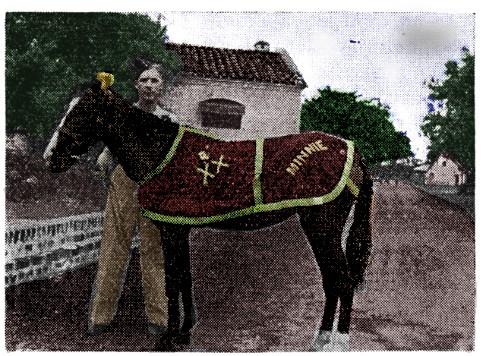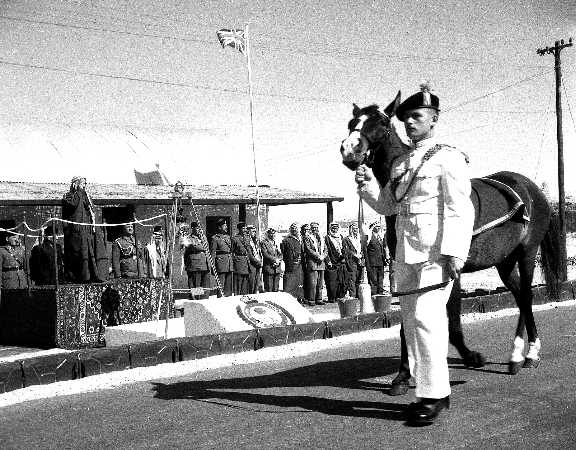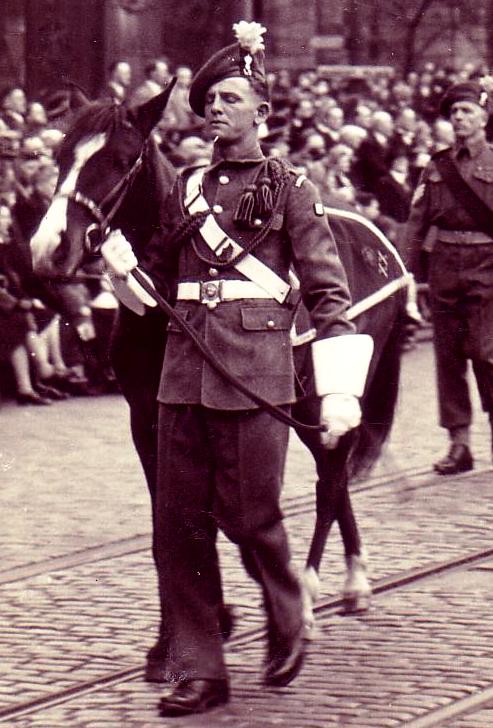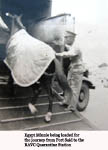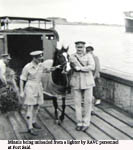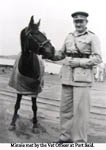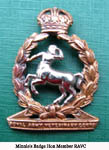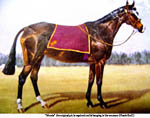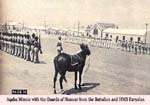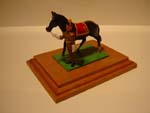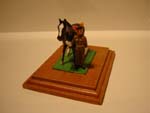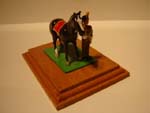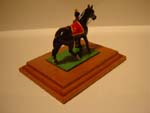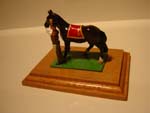|
During operations in Burma in 1944 the 1st Bn XX The
Lancashire Fusiliers
was in the 77th Infantry Brigade, which formed part of the Special Force
commanded by General Wingate.
This force was specially organized and trained for operations behind the
Japanese lines,and men and animals had been specially selected.
In March the 77th Brigade, together with all its men, animal transport
and equipment, was flown into Burma and operated behind the
Japanese lines. The Brigade established a "block" called White
City, across the Japanese road and rail communications to Mytchina.
Six days after the White City block had been established a pack pony in
the Brigade transport platoon unexpectly gave birth to a foal.
There was no record of the pony having been served on the veterinary history
sheet, so the arrival of the foal was a complete surpise.
The foal was born during a determined Japanese attack, and mortar bombs
exploded all round Serjt. Lee, of the 1st Bn XX The Lancashire Fusiliers,
and his staff as they worked to bring new "life" into the "block."
Immediately the troops heard of the new member of the Brigade the foal
became the topic of the day. Something apart from death and destruction
had arrived. During the quieter periods in the fighting, men would stroll
down to the transport lines to see Minnie, so named because she was born
near the mortar post called Minnie. British and Gurkha troops, united
in battle, were all interested in Minnie's progress. During a heavy bombardment
of our positions by the Japanese, bombs fell in the transport lines and
killed several mules. One mule broke loose and, acting as only mules can,
kicked Minnie above the right eye.
It seemed that Minnie might lose the sight of one eye, but Serjt.Lee worked
ceaselessly, with improvised veterinary kit, to save her eye.
Brigadier Calvert, "Mad Mike" as our Brigadier was affectionately
nicknamed, ordered periodic reports on Minnie's progress to be sent to
all forward positions. As Minnies's condition improved so did the morale
of the troops defending the "block." When she was better, she
was often seen walking off to the mortar positions, where she would drink
tea out of a pint pot. The advent of Minnie had definitely helped morale,
and stories of Minnie's pranks and antics, however trivial, brought happiness
to everyone in the Brigade.
When orders were received to evacuate the "block", the problem
of what to do with Minnie, who was still too young and weak to march far,came
up. The Brigadier,
appreciating the part Minnie had played in building up the troops' morale,
decided to have her flown back to India.
An attack to clear the airstrip was ordered and was successful. An aircraft
was able to land and every man "stood to". There were tense
faces as Minnie was placed in the aircraft and there was a sign of genuine
relief as the plane took off. It was sad to see Minnie go, but the troops
had been told that she would be well looked after by the rear party which
had been left behind in India. On 1st August,1944, the anniversary of
the Battle of Minden, the Battalion returned to Dehra Dun in India, for
rest and reorganization. Minnie was there to greet the Battalion,and,
although she actually belonged to the Brigade, she made her home with
the Lancashire Fusiliers. She soon began to control the Battalion. She
used to enter the Serjeants' Mess and eat anything she fancied, including
tablecloths.
Once, during the Adjutant's drill parade, Minnie decided
to join Serjt.Lee on parade, and it was amusing to see Minnie prodding
Serjt.Lee in the back. The Adjutant
eventually decided to dismiss the parade, so again Minnie's reputation
soared. She was the only animal that could get the Battalion off a drill
parade thirty-five minutes before time. When the Brigade was disbanded
Minnie was allowed to remain with the Lancashire Fusiliers and the Commanding
Officer promised that she would always be well cared for. In October,1947,
when the Battalion left India permission was obtained for Minnie to be
brought to England, and she travelled on the aft deck of the troopship
"Georgic," where she was a constant source of interest to a
large and admiring audience. She soon got her sea legs; her appetite never
suffered and she would frequently be seen eating anything from Spam to
Condensed milk which was offered her by the troops.
On arrival in England, the Battalion was first stationed
at Wem in Shropshire, and it was decided in future Minnie should take
part in all ceremonial parades and other appropriate ceremonies. Minnie
was therefore prepared and trained to take her place on parade. A ceremonial
bridle and shabrack were purchased for her and her positions on parade
were fixed.
Her first official duty was in April when she accompanied the detachment
of the Battalion to Bury on Gallipoli Sunday and took part in the parade
after the service in Bury Parish Church.
Soon after this, when the Battalion took over the duties of Demonstration
Battalion at the School of Infantry, Minnie moved with the Battalion to
Warminster. Here she paraded on all ceremonial parades and all guards
of honour furnished by the Battalion during the two years they remained
there. The most important of these were the Trooping the Colour on Minden
Day 1948, the amalgamation parade of the First and Second Battalions on
Minden Day 1949, and the farewell church parade in Heytesbury, just before
the Battalion left for overseas service in the Middle East.
The pony masters were first, Fusilier Priest and later Fusilier Dwyer.
Before leaving for the Middle East, the Battalion paraded in Bury with
bayonets fixed and colours flying, a privilege granted to them when given
the Freedom of the town. Minnie paraded with the Battalion on this occasion.
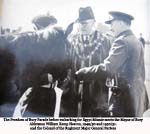
She was not able to travel with the Battalion in HMT Empire Fowey, owing
to the limited deck space on this ship, so she travelled a few weeks later
on another troopship with Fusilier Dwyer.
On arrival in Fayid, Minnie was stabled with the horses of the Army Saddle
Club. She started her duties with the Battalion soon after her arrival
by taking part in the ceremonial guard mounting parades at the C-in C's
residence. She next paraded with the Battalion on the King's Birthday
Parade in June and on Minden Day she took part in Trooping the Colour
when the C-in-C, General Sir Brian Robertson took the salute.
When the Battalion moved to Aqaba in Transjordan in January, 1951, Minnie
travelled later from Suez. At Aqaba she was stabled on her own, and grain
and forage were obtained from the Arab Legion.
In March 1951 she again paraded with a special guard of honour for HM
King Abdullah of Transjordan, when he visited the Battalion. In April
she took part in the combined ceremonial parade of the Battalion, and
HMS Euryalus, when the ship visited Aqaba to hold a reunion with the Battalion
in commemoration of the Lancashire Landing at Gallipoli.
In June, when the Battalion moved by air to Moascar in Egypt, Minnie followed
on later. She was stabled in the Royal Army Veterinary Corps lines which
were alongside the Battalion's barracks. She attended all church parades
and again took part in the ceremony of Trooping the Colour on Minden Day.
Minnie had always been in the best of condition and L/Cpl Dwyer who had
been her pony master invariably turned her out in an exemplary manner
for all her parades. On all ceremonial occasions Minnie wore here shabrack,
of rose colour with gold edge and with a red rose and gold XX in the rear
corner. In Ismalia, Minnie caught pneumonia and died on the 8th November
1951.
Albert Dwyer, former groom of Minnie the mascot died on the 21st September
2000.
I have established that "Minnie" was buried in the camp at Moascar.
Before her internment her tail and four hooves were removed. Two of her
hooves were made into an inkwell and paperweight and together with her
tail and ceremonial blanket are on show in the Regimental Museum in Bury.
The remaining two hooves were given to the Boroughs of both Bury and Rochdale
in remembrance of "Minnie." The XX The Lancashire Fusiliers
enjoys the Freedom of both these towns. I feel that I have now come to
the conclusion of my story, no doubt there are many more amusing tales
to tell of "Minnie."
Roy Woods
© Lancashire Fusiliers website: Joseph Eastwood,Colin
Boutty.
Addendum:
Minnie's hooves are on display at The Regimental Museum
in Bury. Below is a photograph of them. Not a very dignified end to such
an eventful life!
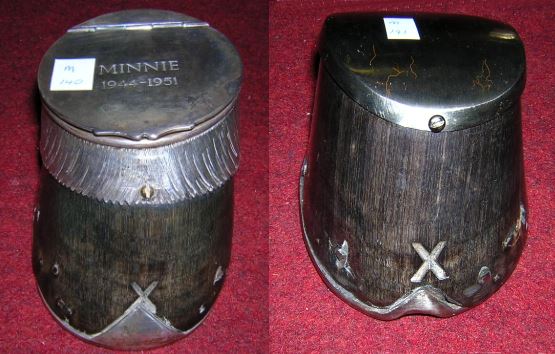
Continued by
Maurice Taylor
OIC Minnie the Mascot
When we first established comns you asked me about
my involvement with Minnie so I thought I would jot down what I could
remember which might be of interest.
At the end of 1949 the Battalion was warned for three years overseas service
and in January 1950 we were officially told we were going to Cyprus. A
few weeks later this was changed and we were told it was on the cards
that we were going to Malaya which was then at the start of the Malayan
Emergency campaign. This was wrong also and in February it was announced
that we would definitely have a one year non-families posting to Egypt
- confusing isn't it? We could then really start our preparations for
the move.
I was summands by the Adjutant Capt Dudley West and told I was to be OIC
Minnie and to get on with her move overseas. Fusilier Albert Dwyer was
the Pony Master and with the help of Sgt Hampson and his Pioneer Platoon
we built a special box for her to travel in on the ship.
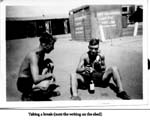
The Battalion sailed to Egypt on the Empire Fowey but we were unable to
get Minnie a passage on this ship so we fixed for her to follow on HMT
Devonshire out of Southampton in early May. I travelled up from Fayid
to meet Fusilier Dwyer and Minnie at Port Said when the Devonshire docked
on 12 May 50 . Unfortunately the ship had a very rough passage and poor
old Minnie had been seasick, never have I seen a more miserable pony she
looked as though she was going to die any moment. We got her off quite
safely and loaded her into a horse box for the run to the Quarantine Depot
in Moascar. When I left her she looked as though she was cheering up a
little as she was in a stable with fifty mules that had just arrived from
Cyprus.
From then on she joined in all our ceremonial duties and parades throughout
the Canal Zone and it was always a sight for sore eyes to see her in her
parade kit.
When we move to Aqaba in January 1951 I handed over responsibility for
the move to my friend Ken Scragg and she sailed from Suez on the LST Empire
Roach. I met them on the dockside at Aqaba where I received the most almighty
bollocking from our CO Lt Col Geoffrey Bamford when he found out that
Minnie had travelled between decks and not in the fresh air on the open
deck....perhaps I deserved it? There can't be too much justice. The Arab
Legion turned up trumps with stabling and forage during our stay in Transjordan
and Albert Dwyer kept Minnie in fine form.
About this time the Battalion commissioned Juliet McLeod the distinguished
painter of horses to paint Minnie's portrait. She produced an enchanting
painting which captured not only Minnie's likeness but also her personality.
The last I saw of this portrait it was lying on it's side in the Museum
in Bury with a hole in it. I do hope it has now been restore to it's former
glory?
We returned from Aqaba to Moascar where again Minnie was well looked after
by Albert Dwyer in the Vetinary Stables. At this time a lot of Fusiliers
turned their hand into being grooms when the troubles started in Ismalia
as the fifty Arab stable hands walked out and never returned. It was fun
for us exercising the horses and joining in the stables management but
I seem to remember a lot of horses, mules and dogs had to go because the
RAVC staff and Vets could not cope without native labour.
In early November 1951 Minnie fell sick with a severe chill and after
about ten days sadly gave up the ghost. We buried her in the hot desert
sands of Egypt. There will never be another one like her, she was a great
Fusilier who contributed enormously to the XXth.
Yesterday I realized I had some photos of meeting Minnie
at Port Said. Eventually I found them and they are attached. The Royal
Army Vetinary Corps Vets and Staff contributed a lot to her well being,
health, stabling, forage, transport etc. She must have been "taken
on strength" and probably had an RACV number somewhere? Anyhow she
was given an honorary "cap-badge" see photo also attached.
MauriceTaylor
OIC Minnie the Mascot
|

